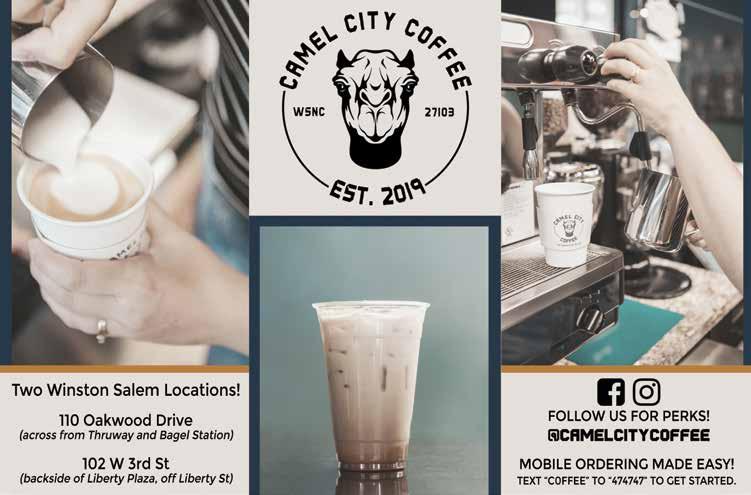
7 minute read
Arrivals, Departures, and the In-Between
from FF Feb 2021
by Forsyth Mags
BY JEAN MARIE JOHNSON
I am a huge animal lover and cannot imagine life without the companionship and comfort of dogs, the precocity of birds, and the surefootedness of turtles.
Advertisement
Last summer, a great-looking tortoise showed up in my natural area. With a mere glimpse of him from my veranda, I was downstairs in a heartbeat to make his acquaintance. Seeming rather disinterested, he remained fairly stationary for a brief photo shoot. I named him “Chester” and invited him to stay. We carried him over to a pile of rocks, added a pan of water and, much as a motivated realtor would, encouraged him to survey the habitat in the hopes that he would find it appealing. Apparently, he did not. Or maybe he simply had other plans?
Shortly thereafter, I opened my front door to find a gray beauty hanging out. He meowed in an animated, feline version of ringing the doorbell. I named him “Slate.” Over the next 48 hours, this persistent, talkative fellow took up residence on my porch, on my lawn and in my bushes. He peered into every accessible door and window, impatiently awaiting an invite. While my love for him was immediate, I knew we could not keep him. I posted on our neighborhood site, to no avail. My awesome-beyond-words neighbor brought over cat food (the good stuff, no less). I gave him milk and water and then settled in to see what was next. Unlike Chester, Slate needed no sales pitch to find my digs to his liking. He then disappeared as quickly as he had appeared. Perhaps he realized that he’d never be invited over the threshold?
How is it that our hearts take that unconditional leap of faith with animals, anyway? These “arrivals” were blissful. And while their tenure was short, my “heart leap” was deep.
It made me wonder if these two experiences had prepared me for yet another arrival and departure.
It was early morning when I opened the screen door to water my late summer plantings. I immediately heard a thrashing in the early fall leaves. Looking to my right, I saw it—a house finch with what appeared to be a broken neck. I slowly approached as my mind raced—what can I do, is there someone I can call? I watched as he took his last breath and then settled into the unmistakable stillness of death. I paused with the bone-deep awareness that was nothing I could do. I didn’t know how he was injured, and for a moment, felt guilty that my startling him had hastened his inevitable demise.
And that’s when it hit me. That bird ate from my feeder, drank from my birdbath and likely had a nest tucked ever-so-carefully on my house. I had provided the invite, the welcome, my form of love. I had “done right” by this little bird.
Collecting myself in the chill of our first fall-like day, I picked up my trowel, a makeshift gurney. I looked at the still life that was this bird and placed him on the ground. I walked over to an old, worn cross I had picked up at an estate sale that summer, dug a small hole beside it, and placed the little bird there. Then I thanked him for bringing his own special life to this place I call “my” home and wished him everlasting peace.
Birth followed inevitably by death. Arrivals eventually followed by departures. While these are happy and sad bookends, all that matters is what lies between them. All that matters is what we do in the in-between.

What If?
Presents Storing Long Term Food Items BY LISA S.T. DOSS
Embedded in our minds is the worrisome mantra, “what if” that spans topics from safety and financial security to the health of loved ones, pets and self. Pondering “What can I do?” leads to a proactive decision to invest time in the ultimate insurance policy – valuable life skills comprising security, shelter, food, water and medical care! In any emergency from extreme weather to a personal disaster, you have the power to take charge of your fate by making plans and taking action!
Humans have a fond connection to items of comfort. On the top of the list is food, following a lengthy list of items defined by a feeling of wellbeing or consolation. Perhaps the recipe has an association to childhood or Mom’s home cooking, or containing chocolate or high sugar! As needs arise, the first step is to open pantry and cupboard doors and start extracting frequently used ingredients. Did you ever think about how often you open containers of sugar, flour, baking soda and salt? Rather than continue to purchase small bags, why not invest in bulk and start a longterm storage pantry?
Reaching Maximum Shelf Life
Almost every container, whether plastic, papered or boxed, is not meant for sustainability. Bread wrapped in plastic bags eventually leads to mold if not eaten quickly. The solution is to change the food’s environment to ensure prolonged and stable shelf-life. Dry pasta left in its original packaging will last up to two years. Add eight years if vacuum sealed, and kept at a stable temperature of 70 degrees. While you can reseal bags, consider Mason jars and reuse the lid.
• With a hand-held, battery-powered sealer for regular and wide-mouth jars, consider having on-hand frequently used items, such as coffee, bulkloose teas, rice, beans, dehydrated soups, bouillon powder and salt. Just grab a quart jar and use until emptied!

TIP: Place a paper towel over powdered contents, such as pancake, biscuit and muffin mixes, ensuring particles do not compact hoses and corrupt the device.
FACT: Hard candies like lollipops and Jolly Ranchers have an indefinite shelf life. Peppermint candies last five years! Love dark chocolate? When stored in an airtight container and placed in a cool, dark place, it can last up to three years.
Calcium, Vitamin C and Electrolytes
Bottled water is a must-have when creating a list of essential items. Don’t forget other types of liquids, which add to overall health and nutrition.
• Canned seltzer water lasts indefinitely and improves acid reflux and constipation.
• Unopened canned, powdered milk can last well beyond the “best by” date, approximately a decade, and is a good substitute for calcium.
• Tang provides calcium and vitamin C while boosting energy levels. • Gatorade increases hydration through percentages of bicarbonate phosphate, calcium, citric acid and potassium.
• Other options include canned pineapple, vegetable juice and chicken stock!
FACT: Non-fat powdered milk has a shelf life of 15-20 years.
#10 Cans
Gatherings with family and friends require investing in bulk foods, especially if canned to reduce overall cost. Beyond the vegetables, beans and fruits you can obtain from grocery, warehouse and big-box stores, there are opportunities to buy breakfast, lunch, dinner and snacks with a shelf-life up to 30 years. Start searching online to buy individual or in paired boxes. Research local locations, such as the LDS Cannery, which is open to the public!
FACT: Dehydrated or freeze-dried foods may store for 20 to 25 years.
Buckets and Bags
Most buckets come with a difficult to pry open, snappable lid. The next best option is a Gamma lid, transforming a container into a resealable, airtight and leak-proof storage unit. The BPAfree plastic lid spins open, allowing easy access to retrieve another beneficial storage item, the Mylar bag. Available in multiple sizes, the bag creates an effective oxygen barrier while protecting the contents from light, moisture and the threat of insects! Just imagine how easy it would be to contain flour, Jasmine rice, sugar, baking soda or salt. With labels and dates, anyone can access the bucket and bag, toss in an oxygen absorber and reseal with an iron or hair straightener!
FACT: Never throw away apple cider vinegar, bouillon cubes, corn starch, corn syrup, hardtack, honey, hard liquor, maple syrup, soy sauce, sugar, vanilla extract, white rice or white vinegar; it lasts forever!
Start small! Consider earmarking $40 monthly to increase your food storage supplies! You’re planning for the “what-if” moment, which could be soon or later!
Camel City Coffee

FCDS











